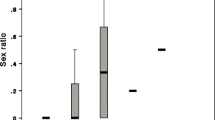Summary
The sex allocation behavior of the solitary egg parasitoid Telenomus heliothidis Ashmead was investigated by examining the response of females reared in isolation and under crowded conditions. Females reared in isolation adjusted their sex ratio with foundress and host number per patch in accordance with the predictions of local mate competition (LMC) theory. However, females did not shift their sex ratio in response to conspecifics foraging on the same host patch or to contact with previously parasitized hosts. Instead, shifts were associated with encounter rate and a sequence of oviposition. Females maintained under crowded conditions responded to host patches much differently. One-day-old females which had lived under crowded conditions for 24 h produced sex ratios similar to those of continuously isolated females. However, females reared under crowded conditions for 7 days consistently produced unbiased sex ratios, and exhibited a different sequence of oviposition. This shift appeared to be due directly to crowding rather than age, oviposition experience or sperm depletion since the effect could be reversed by subsequent isolation.
Similar content being viewed by others
References
Chacko M (1969) The phenomenon of superparasitism in Trichogramma evanescens and T. minutum Riley (Hymenoptera: Trichogrammatidae). I Beit Entomol 19:618–635
Charnov EL (1979) The genetical evolution of patterns of sexuality: Darwinian fitness. Am Nat 113:465–480
Charnov EL (1982) The Theory of Sex Allocation. Princeton University Press, Princeton
Charnov EL, Los-den Hartoch RL, Jones WT, Assem van den J (1981) Sex ratio evolution in a variable environment. Nature 289:27–31
Dijkin MJ van, Waage JK (1987) Self and conspecific superparasitism by the egg parasitoid Trichogramma evanescens. Entomol Exp Appl 43:183–192
Frank SA (1986) Hierarchical selection theory and sex ratios. I General solutions for structured populations. Theor Pop Biol 30:215–231
Godfray HCJ (1986) Models for clutch size and sex ratio with sibling interaction. Theor Pop Biol 30:215–231
Godfray HCJ, Shaw MR (1987) Seasonal variation in the reproductive strategy of the parasitic wasp Eulophus larvarum (Hymenoptera: Chalcidoidea: Eulophidae). Ecol Entomol 12:251–256
Green RF, Gordh G, Hawkins BA (1982) Precise sex ratios in highly inbred parasitic wasps. Am Nat 120:653–665
Hamilton WD (1967) Extraordinary sex ratios. Science 156:477–488
Hamilton WD (1979) Wingless and fighting males in fig wasps and other insects. In: Blum MS, Blum NA (eds) Reproductive competition and sexual selection in insects. Academic, New York, pp 167–220
Hartyl DL (1971) Some aspects of natural selection in arrhenotikous populations. Amer Zool 11:309–325
Herre EA (1985) Sex ratio adjustment in fig wasps. Science 228:896–897
Hubbard SF, Marris G, Reynolds A, Rowe GW (1987) Adaptive patterns in the avoidance of superparasitism by solitary wasps. J Anim Ecol 56:387–402
Jackson DJ (1966) Observations on the biology of Caraphractus cinctus Walker (Hymenoptera: Mymaridae), a parasitoid of the eggs of Dytiscidae (Coleoptera): III. The adult life and sex ratio. Trans R Entomol Soc Lond 118:23–49
King BH (1987) Offspring sex ratios in parasitoid wasps. Q Rev Biol 62:367–386
Luck RF, Podoler H (1985) Competitive exclusion of Aphytis lingnanensis by A. melinus: potential role of host size. Ecology 66:904–913
Nunney L (1985) Female-biased sex ratios: individual or group selection? Evolution 39:349–361
Orzack SH, Parker ED Jr (1986) Sex ratio control in a parasitic wasp, Nasonia vitripennis. I. Genetic variation in facultative sex ratio adjustment. Evolution 40:331–340
Schmidt JM, Smith JJB (1985) Host volume measurement by the parasitoid wasp Trichogramma minutun: the roles of curvature and surface area. Entomol Exp Appl 39:213–221
Schmidt JM, Smith JJB (1987) The effect of host spacing on the clutch size and parasitization rate of Trichogramma minutum. Entomol Exp Appl 43:125–131
Strand MR (1986) The physiological interactions of parasitoids with their hosts and their influence on reproductive strategies. In: Waage J, Greathead D (eds) Insect Parasitoids. Academic, London, pp 97–136
Strand MR, Vinson SB (1983a) Host acceptance behavior of Telenomus heliothidis (Hymenoptera: Scelionidae) toward Heliothis virescens (Lepidoptera: Noctuidae). Ann Entomol Soc Am 76:781–785
Strand MR, Vinson SB (1983b) Analysis of an egg recognition kairomone of Telenomus heliothidis (Hymenoptera: Scelionidae). Isolation and host function. J Chem Ecol 9:423–432
Suzuki Y, Tsuji H, Sasakawa M (1984) Sex allocation and effects of superparasitism on secondary sex ratios in the gregarious parasitoid Trichogramma chilonis (Hymenoptera: Trichogrammatidae). Anim Behav 32:478–484
Takagi M (1986) The reproductive strategy of the gregarious parasitoid, Ptelomalus puparum (Hymenoptera: Pteromalidae). 2. Host size discrimination and regulation of the number and sex ratio of progeny in a single host. Oecologia 70:321–325
Taylor PD (1981) Intra-sex and inter-sex sibling interactions as sex ratio determinants. Nature 291:64–66
Taylor PD, Bulmer MG (1980) Local mate competition and the sex ratio. J Theoret Biol 86:409–419
Vanderzant ES, Richardson CD, Fort SW Jr (1962) Rearing of the bollworm on artificial diet. J Econ Entomol 55:170
Viktorov GA (1968) Effect of population density on sex ratio in Trissolcus grandis Thoms. (Hymenoptera: Scelionidae). Zool Zh 47:1035–1039
Viktorov GA, Kochetova NI (1971) The significance of population density on sex ratio in Trissolcus grandis Thoms. (Hymenoptera: Scelionidae). Zool Zh 50:1753–1755
Waage JK (1982) Sib-mating and sex ratio strategies in scelionid wasps. Ecol Entomol 7:103–112
Waage JK (1986) Family Planning in parasitoids: adaptive patterns of progeny and sex allocation. In: Waage J, Greathead D (eds) Insect Parasitoids. Academic, New York, pp 63–95
Waage JK, Lane JA (1984) The reproductive strategy of a parasitic wasp. II. Sex allocation and local mate competition in Trichogramma evanescens. J Anim Ecol 53:417–426
Werren JH (1980) Sex ratio adaptation to local mate competition in a parasitic wasp. Science 208:1157–1159
Wylie HG (1976) Interference among females of Nasonia vitripennis (Hymenoptera, Pteromalidae) and its effect on sex ratio of the progeny. Can Ent 108:655–661
Wylie HG (1979) Sex ratio variability of Muscidifurax zaraptor (Hymenoptera, Pteromalidae). Can Ent 111:105–109
Author information
Authors and Affiliations
Rights and permissions
About this article
Cite this article
Strand, M.R. Variable sex ratio strategy of Telenomus heliothidis (Hymenoptera: Scelionidae): adaptation to host and conspecific density. Oecologia 77, 219–224 (1988). https://doi.org/10.1007/BF00379189
Received:
Issue Date:
DOI: https://doi.org/10.1007/BF00379189




